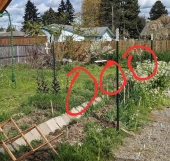Different hoes are for different purposes. Mostly I want one for weeding and "dust mulching" (breaking up soil crust and cracks into fine powder which conserves moisture further down) The ideal weeding hoe CUTS weeds, just below the surface of the soil. So for this I like an ordinary shape and sized blade, lightweight, and a long handle. The motion of the hoe over the soil is comparable to that of a broom over a floor....one should be able to do it for hours on end without tiring. Sharpening the edge is vital, and needs touching up every half hour or hour's worth of work, moreso if there is gravel etc. I also use a small pointed blade hoe....made from one tooth of a sicklebar mower....to take out single furrows of various depths for planting seeds. I've also used what they call a grub hoe in the South, with a heavy wide blade which is meant for breaking up heavy clods, chopping out heavy roots and stubs, and so on....jobs for which many people prefer a shovel and/or a pick. A thing very like this, with a short handle, is the default soil working tool in much of the Third World, and it has always puzzled me....why people use that so much and not a shovel which seems so much easier on the back having tried both.






